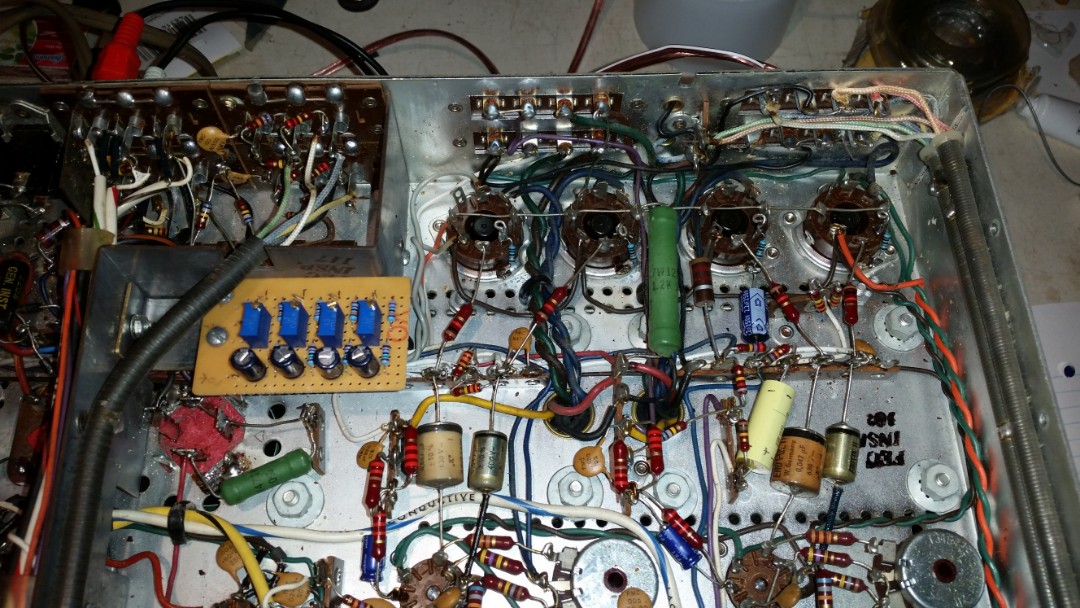07-20-2019, 11:18 PM
Lots of progress today and IBAM is working nicely.
I cut down the board, made mounting holes for the fixing bracket, and added wires for supply and distribution to each output valve. Then the board was tacked on to the -24v line, and the outputs all set to -18V - a good margin of safety for starting bias values.
The board was then fixed in to place, and I went about disconnecting the stock bias connections. This was achieved simply by detaching the 300 kOhm resistors from their tie in to the signal feeds. The loose ends were soldered back on to the tag for each resistor connected to the stock bias supply (connecting them to themselves). In this way, no parts were removed. Wires were run back to the -24 V point, and fly leads were connected from the IBAM board to the valve grids. I wanted to test proper, stable operation before the hard work of dressing all the leads along the chassis with the existing wiring.
Tests showed I had targeted the starting bias nice and low, with the voltage across the 10 Ohm cathode resistors indicating ~200 mA bias or a little more. Never having done this before, I tweaked away, then waited. The valves continued to settle in over several minutes, and I chased the adjustment to 320 mA. The multi turn pots are perhaps overkill, but weren't expensive, and the form factor suited construction on perf-board.
There was a bit of excitement when a probe slipped, and the screen supply was inadvertently connected to the cathode. The fusible resistor used in the cathode circuit did its thing... It was replaced (lucky the minimum order was 20), and I could not get bias to read sensibly on one of the valves. Alarm bells, large bias reading, a glance at the valve showed the anode just starting to acheive red heat. Power off! I'd disconnected one of the tacked flying bias leads when the "Crack!" of the short circuit made me jump. Fixed, checked, all well again.
With that, the four bias wires were routed carefully along the chassis, and the receiver tested again. Here is the finished installation.

Cheers
Ed
I cut down the board, made mounting holes for the fixing bracket, and added wires for supply and distribution to each output valve. Then the board was tacked on to the -24v line, and the outputs all set to -18V - a good margin of safety for starting bias values.
The board was then fixed in to place, and I went about disconnecting the stock bias connections. This was achieved simply by detaching the 300 kOhm resistors from their tie in to the signal feeds. The loose ends were soldered back on to the tag for each resistor connected to the stock bias supply (connecting them to themselves). In this way, no parts were removed. Wires were run back to the -24 V point, and fly leads were connected from the IBAM board to the valve grids. I wanted to test proper, stable operation before the hard work of dressing all the leads along the chassis with the existing wiring.
Tests showed I had targeted the starting bias nice and low, with the voltage across the 10 Ohm cathode resistors indicating ~200 mA bias or a little more. Never having done this before, I tweaked away, then waited. The valves continued to settle in over several minutes, and I chased the adjustment to 320 mA. The multi turn pots are perhaps overkill, but weren't expensive, and the form factor suited construction on perf-board.
There was a bit of excitement when a probe slipped, and the screen supply was inadvertently connected to the cathode. The fusible resistor used in the cathode circuit did its thing... It was replaced (lucky the minimum order was 20), and I could not get bias to read sensibly on one of the valves. Alarm bells, large bias reading, a glance at the valve showed the anode just starting to acheive red heat. Power off! I'd disconnected one of the tacked flying bias leads when the "Crack!" of the short circuit made me jump. Fixed, checked, all well again.
With that, the four bias wires were routed carefully along the chassis, and the receiver tested again. Here is the finished installation.
Cheers
Ed
I don't hold with furniture that talks.



![[-] [-]](https://philcoradio.com/phorum/images/bootbb/collapse.png)


